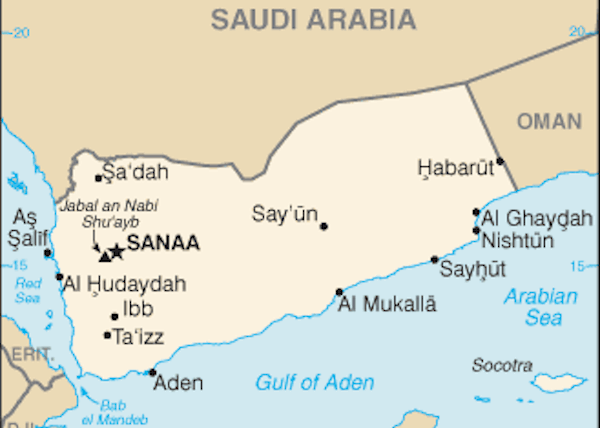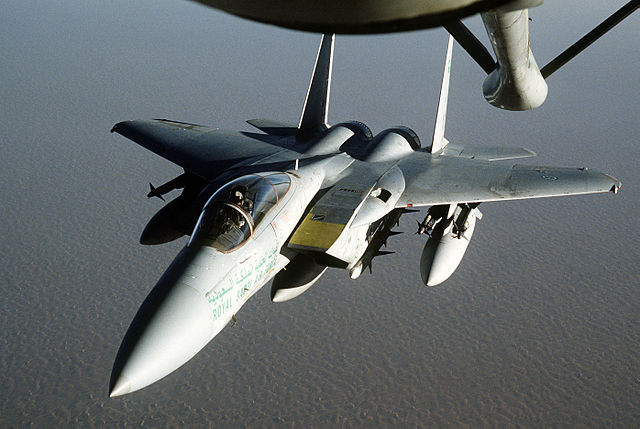Saudi Arabia’s war in Yemen against various rebel factions has come to involve ground troops from the UAE, Qatar, Egypt, Sudan, as well as various countries’ jets. A recent ceasefire seems doomed to fail.
And yet it has taken a full year for the Saudi government to present even the flimsiest explanation of its reasons for undertaking the war to begin with or to mount a public defense of the war’s course.
It came in the form of an ungrounded, feel-good propaganda piece by Ambassador to the United States Prince Abdullah Al-Saud in the pages of the Wall Street Journal in March 2016.
Even the Prince admits that it was hardly obvious to the public – or to himself! – why the Kingdom launched the war in the first place:
I was out of government service when the operation was launched. So like many Saudis, I wondered why the kingdom had taken this unusually bold action.
Remarkably, despite an incoherent raison d’être, the Saudi-led coalition operates with substantial logistical and munitions support from the United States. And despite the potent weaponry brought to bear, as we projected last year, the campaign has failed to re-take much beyond a (fragile) southern beachhead.
Was there a plan B?
Did the Saudi coalition have a backup plan if a broader takeover failed? A possible solution, to Saudi planners, appears to be splitting the country up.
Such an intended outcome may sound exaggerated or alarmist. However, those who are familiar with Yemen’s history over the last several decades would not be surprised if it emerges that an unacknowledged goal of Saudi Arabia’s war is partition.
Yemen, a very poor country that was widely seen before the war as a paradigm for a failed state, sits across a 1,100 mile long border from wealthy, powerful Saudi Arabia.
Yemen’s population – about 27 million – is nearly the same size as Saudi Arabia’s (26 million), even though the former’s territory is only 1/4th that of its much richer neighbor to the north. Meanwhile, Yemen’s per capita income is only 1/20th of Saudi Arabia’s.
At their root, Yemen’s challenges are socio-economic in character. Attempting to bomb them away, as Saudi Arabia has tried for some time now, are doomed.
When Yemen’s Saudi-imposed post-Arab Spring political solution was overthrown, the Saudis decided in March of 2015 to plunge themselves into the conflict in Yemen.
Just like the Americans in Iraq, Afghanistan and beyond, they counted on the superiority of their armaments and war technology to win the war quickly – and finally resolve that persistent problem next door.
Destroying Yemen’s infrastructure
The only real effect of the Saudi air campaign, however, has been to destroy whatever little infrastructure Yemen had before.
Highways, bridges, ports, even water pipelines have been sacrificed by Saudi policymakers, putting Yemen’s future economic potential ever deeper into a hole.
The later introduction of ground troops from a constellation of Arab countries did little to improve the picture. As this campaign unfolds, Yemen will only be more broken and unable to generate any realistic prospect for jobs or wealth.
Why then did Saudi Arabia pursue such a strategy? The conventional wisdom is that it simply followed the U.S. path – unwisely overestimating the power of high-tech warfare.
But the Saudis, famed for their interest in preserving regional balance, have long had a front-row seat to the rather disastrous unfolding of America’s strategy in the region. They may be stubborn, but they certainly are not stupid.
Moreover, the argument that Saudi Arabia just followed the U.S. example does not account for the extent of the physical and human devastation from Saudi raids and naval blockade. Thousands of people went hungry for half a year or more and 20 million lack safe drinking water.
Thousands of civilians have been killed in very poorly targeted airstrikes, including many by Saudi aircraft flying too high for accurate bombing to be possible.
Considering the widespread destitution that was already present in Yemen before any Saudi actions, it is incomprehensible what the shattering devastation produced in the past year should possibly yield, with regard to the stated goal of intervening to stabilize Yemen.
Darker motives
The best explanation for the bull-in-a-china-shop approach the Saudis have taken in Yemen to date is this: Saudi Arabia would rather demolish and break up Yemen into its former two halves again than have it remain united. After all, the latter scenario might entail dealing with a potentially hostile state. Split into two parts, Yemen might be much less of a problem.
Consider the historic dimension in support of this hypothesis: First, Saudi Arabia never supported the amicable unification of north and south Yemen in 1990, under North Yemen’s leadership.
In fact, the Saudis had tried to prevent this event from happening repeatedly in the preceding decades. They also made efforts to undo it throughout the 1990s, mainly by supporting southern Yemeni leaders and secessionist groups.
Each time, this involved the Saudis delivering more arms to one faction or another – which contributed to Yemen becoming the country in the world that ranks second only to the United States in per capita gun ownership.
Incredibly, the Saudi ambassador to the United States insisted, in his op-ed, that “The Saudi government has been the largest supporter of successive Yemeni governments.”
Second, Yemen’s Saudi-installed “transitional government” – which was established in February 2012 and which the Houthis ejected in 2015, triggering the intervention – was filled with southerners from Aden. It replaced the northern-dominated regime that had unified the country in 1990.
Third, Saudi Arabia has concentrated its war efforts on recapturing and (not very successfully) securing Aden, the former southern capital. The Saudi intervention did not begin after the rebel takeover of Sana’a, the country’s capital in the north, but rather the fall of Aden.
While moves northward have been made, the bulk of foreign military attention has been on former South Yemen regions.
Fourth, tellingly, Saudi-armed local ground forces are actually called the “Southern Resistance” and include southern secessionists. Pro-Saudi demonstrators outside a 2015 White House summit with King Salman openly displayed South Yemeni flags.
Flawed Saudi strategy
The ultimate point to be raised in support of the partition thesis is this: If partition is the ultimate goal, then the “strategy” pursued by the Saudis in Yemen is not cruelly incompetent — but rather quite effective, albeit brutal.
Pummeling Yemen from the air and invading parts of it may be a path toward a permanent partition. Thus, whether by accident or design, Yemen’s unification is being reversed 26 years later.
How does that align with the interests of the United States? In short, it does not. U.S. policy, right or not, has been that preserving existing borders at all costs is the way to maintain regional stability.
In contrast, Saudi Arabia – a nation of formerly nomadic peoples in a theocratic system that never cared much for earthly borders – seems to prefer a divide-and-conquer strategy.
Ultimately such a Saudi strategy – particularly in Yemen – would be even more devastating and shortsighted than the approaches pursued in the region by the United States at its worst, most strategically shortsighted moments.
Even assuming this “grand” strategy were to “work,” in the sense of successfully splitting up Yemen, all it would really achieve is the genesis of another ISIS-style group, this one grown in the lawless Yemeni hinterland incubator that once grew an al Qaeda affiliate into the main branch.
That is hardly in Washington’s interest. Nor is it really in the Saudis’ interest. And yet, that may be precisely what is happening.
Learn from Libya’s past
One only need look to Libya’s recent past to see where this strategy will lead. Consider it Yemen’s prologue under the current course. In Libya, Egyptian and UAE bombardments have not re-united the country’s historic rival halves. Rather, they hardened the partition between them.
And in that Libyan breach, ISIS established its most active “provinces” outside of the Syria-Iraq battlefields.
Such a scenario next door in Yemen is the last thing that Saudi Arabia, a giant who stands on clay feet, needs to create. U.S. interests demand that the Obama administration does not let the Saudis, no matter how important an ally they are, go unperturbed about its evidently disastrous – and inhumane – strategic path.
Originally published at The Globalist.







